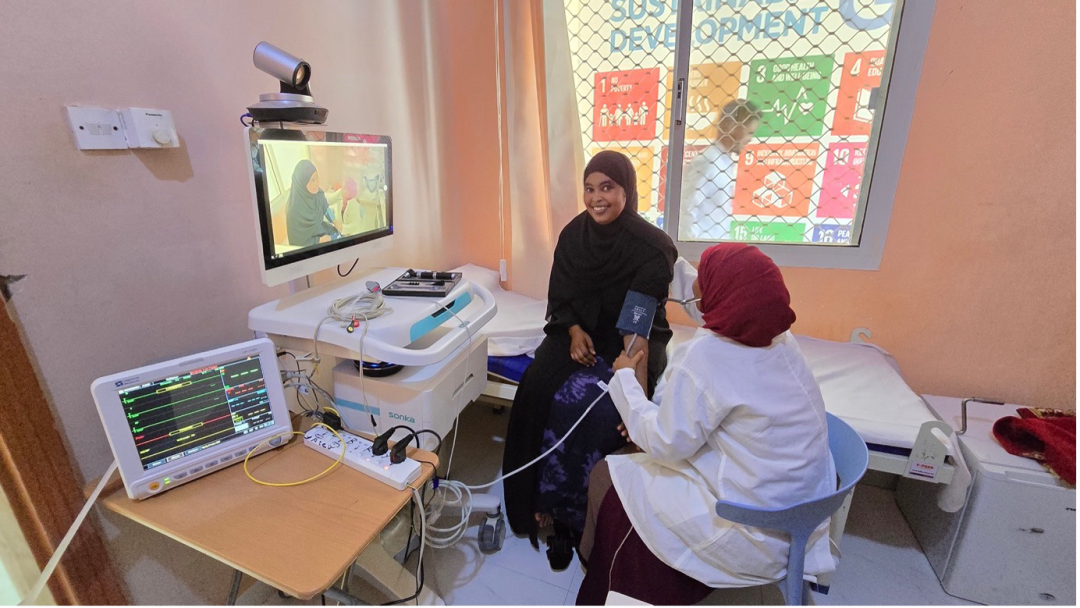Disclaimer:
Please be aware that the content herein has not been peer reviewed. It consists of personal reflections, insights, and learnings of the contributor(s). It may not be exhaustive, nor does it aim to be authoritative knowledge.
Learnings on your challenge
What are the top key insights you generated about your learning challenge during this Action Learning Plan? (Please list a maximum of 5 key insights)
The lab began by procuring 8 sets of equipment to connect different regions in Somalia. The plan was to install 5 of these sets in youth centres with small clinics located in low-income urban areas, linking them to more specialised local hospitals. These areas are home to internally displaced persons who either cannot access or afford specialised second opinions or external medical consultations. After this experimental phase, the next step would be to expand the network to remote areas. However, we found that starting with a broad scope across three regions (north, east-central, and south-central) slowed down the process of generating results, particularly in such a complex country. Instead, we realized it would be more effective to focus our efforts and resources on one region at a time, expanding to others as more resources become available and as the country office takes over. Starting with a broad scope is typical for our country offices, but this approach often leads to resources being spread too thinly across small pilot projects, limiting both effectiveness and impact, while also extending the project timeline.
- After partnering with the Islamic Development Bank, Indonesia Aid, East Africa University Hospital, and Ain Shams University Hospital as part of a larger project to establish ICUs and telemedicine facilities in the east-central and Puntland regions, we quickly realised an important lesson. Even a single telemedicine installation requires more than just expensive equipment; it depends heavily on a comprehensive network of partnerships and strong relationships with the government, medical facilities, local users, and the surrounding community where the telemedicine centre is located.
- A key factor for the success of a telemedicine system in low-income communities and rural areas is the availability of skilled support staff. This is why expanding the network of specialist doctors needs to include more external expertise. To address this, we joined the previously mentioned IsDB project, and now our nursing staff at the youth centres are being trained to use specialised software for recording medical information, along with other essential skills required for telemedicine services.
- Another important lesson involves expanding the network of doctors to include specialists from the Somali diaspora, particularly those who speak Somali. We discovered that language barriers are often the most significant obstacle to effective communication between doctors and patients, especially in online consultations.
- In collaboration and learning sessions with the Libyan telemedicine startup Speeter, we gained valuable insights. We learned that expensive equipment is not necessary for a successful telemedicine facility. Instead, the focus should be on building networks between the supply and demand sides. Additionally, obtaining certification from the Ministry of Health for both the supply and demand ends is crucial.
Considering the outcomes of this learning challenge, which of the following best describe the handover process? (Please select all that apply)
Other
Can you provide more detail on your handover process?
The pilot is being taken up by East Africa University Hospital , IsDB and Ain Shams University Hospital as part of a big project, but that is in Puntland.
Please paste any link(s) to blog(s) or publication(s) that articulate the learnings on your frontier challenge.
The blog is in process for publishing
Data and Methods
Relating to your types of data, why did you chose these? What gaps in available data were these addressing?
These data sources gave us an idea of user needs at the telemedicine service centres. To understand the hosting communities as well.
Why was it necessary to apply the above innovation method on your frontier challenge? How did these help you to unpack the system?
Partners
Please indicate what partners you have actually worked with for this learning challenge.
Please state the name of the partner:
Ain Shams University Hospital
What sector does your partner belong to?
Academia
Please provide a brief description of the partnership.
The teaching hospital is part of the IsDB project to deliver medical consultations to the telemedicine facility and training for staff.
Is this a new and unusual partner for UNDP?
Yes
End
Bonus question: How did the interplay of innovation methods, new forms of data and unusual partners enable you to learn & generate insights, that otherwise you would have not been able to achieve?
Please upload any further supporting evidence / documents / data you have produced on your frontier challenge that showcase your learnings.
The closing form saves automatically or via the blue "save changes" button the top left. Thank you


 3Good health and well-being
3Good health and well-being 10Reduced innequalities
10Reduced innequalities
Comments
Log in to add a comment or reply.